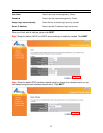
35
3.1.3 NAT / Static Routing
Network address translations (NAT) shares a single public IP address to multiple computers. All
computers must be assigned a valid public IP address to be able to get connected to Internet,
but Internet service providers provide very few public IP addresses to each user based on
service plans, usually 1 for each household. Therefore, it’s necessary to use NAT technology to
share a single Internet IP address to multiple computers on a same local network, so everyone
can get connected to Internet.
The NAT function is enabled by default; to disable it, you need to enable Static Routing by
checking the “Enable Static Routing” box. Do not disable NAT unless you have professional
knowledge on routing.
Please follow the following instructions to set Static Routing parameters:
Parameter Description
Enable Static Routing Check/uncheck to disable/enable the NAT function.
Destination LAN IP Enter the IP Address of the destination LAN.
Subnet Mask Enter the Subnet Mask of the destination LAN.
Default Gateway This is the gateway IP Address where packets are sent. Input
the gateway IP Address.
Hop Count Enter the maximum number of steps between network nodes
that data packets will travel. A node is any device on the
network, such as a computer, print server, or router.
Interface This interface tells you whether the Destination IP Address is on
the LAN & Wireless (Ethernet and wireless networks) or the
WAN (Internet).
Add Click on Add to add the routing rule to Router’s routing table.
Reset You can also click ‘Reset’ button to clear all data you entered.


















